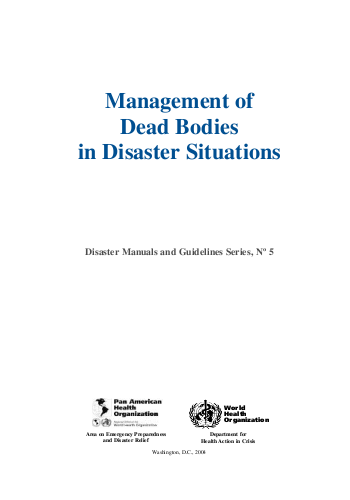
Major disasters occurring in this Region, regardless of their origin, have had one thing in common: an enormous number of fatalities. Hurricane Mitch in Central America, floods in Venezuela, the earthquake in El Salvador, hurricanes in the Caribbean, and disasters of human origin—such as the Mesa Redonda fire in Lima, wars, or aviation accidents, to name a few—have resulted in many deaths. Each disaster has yielded important evidence about handling bodies, particularly when the number of dead overwhelms the capacity of a country to effectively respond to an emergency. Immediately following the onset of a disaster, it is essential for national, regional, or local authorities to concentrate their actions and resources on three basic activities: first, the rescue and treatment of survivors; second, the repair and maintenance of basic services; and, finally, the recovery and management of bodies. Controversy has always surrounded the handling of mass fatalities. Myths about treatment of the dead are strongly rooted in culture. Contemplating massive measles vaccination campaigns after an earthquake because of the fear that corpses could transmit this disease, or burying or incinerating corpses without completing required identification processes because of the supposed contamination risk they pose, are just two examples of the myths that form part of the popular culture. Despite efforts by experts to dispel these and other beliefs, certain fallacies have led and continue to lead to unacceptable practices in managing dead bodies. For example, after the earthquake in India in 2001, in which the number of fatalities approached 100,000, the bodies recovered were cremated. The wood supply was quickly exhausted, leaving the survivors without enough fuel for cooking or heating.1 Considering these factors, PAHO’s Area on Emergency Preparedness and Disaster Relief has developed this manual as a tool to be used by national and local authorities and professionals from public institutions that are affected by this issue. This manual provides the technical information that will support the correct approach to handling dead bodies, taking into account the following principles: u When death is the result of a disaster, the body does not pose a risk for infection; u Victims should never be buried in common graves; u Mass cremation of bodies should never take place when this goes against the cultural and religious norms of the population; u Every effort must be taken to identify the bodies. As a last resort, unidentified bodies should be placed in individual niches or trenches, which is a basic human right of the surviving family members.
Resource collections
- Evaluating humanitarian action
- UN Habitat - Urban Response Collection
- Urban Response - Urban Crisis Preparedness and Risk Reduction
- Urban Response Collection - Community Engagement and Social Cohesion
- Urban Response Collection - Economic Recovery
- Urban Response Collection - Environment and Climate Change
- Urban Response Collection - Housing, Land and Property
- Urban Response Collection - Urban Crisis Response, Recovery and Reconstruction
- Urban Response Collection - Urban Resilience